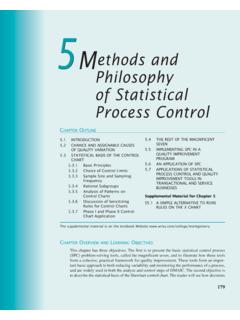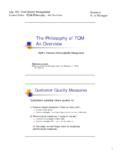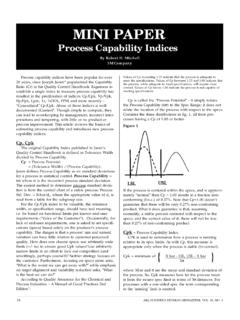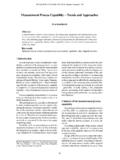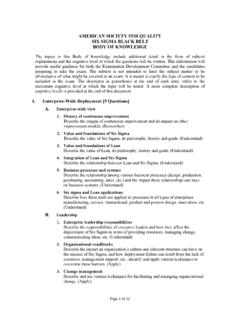Transcription of I Sixth Edition ntroduction to - dl4a.org
1 Sixth Edition I. ntroduction to statistical Quality control DOUGLAS C. MONTGOMERY. Arizona State University John Wiley & Sons, Inc. Executive Publisher: Don Fowley Associate Publisher: Daniel Sayer Acquisitions Editor: Jennifer Welter Marketing Manager: Christopher Ruel Production Manager: Dorothy Sinclair Production Editor: Sandra Dumas Senior Designer: Kevin Murphy New Media Editor: Lauren Sapira Editorial Assistant: Mark Owens Production Management Services: Elm Street Publishing Services Composition Services: Aptara, Inc. This book was typeset in 10/12 Times by Aptara, Inc., and printed and bound by R. R. Donnelley (Jefferson City). The cover was printed by R. R. Donnelley (Jefferson City). The paper in this book was manufactured by a mill whose forest management programs include sustained yield harvesting of its timberlands. Sustained yield harvesting principles ensure that the number of trees cut each year does not exceed the amount of new growth.
2 This book is printed on acid-free paper. Copyright 2009 by John Wiley & Sons, Inc. All rights reserved. No part of this publication may be reproduced, stored in a retrieval system or transmitted in any form or by any means, electronic, mechanical, photocopying, recording, scanning or otherwise, except as permitted under Sections 107 or 108 of the 1976 United States Copyright Act, without either the prior written permission of the Publisher or authorization through payment of the appropriate per-copy fee to the Copyright Clearance Center, 222 Rosewood Drive, Danvers, MA 01923, (978) 750-8400, fax (978) 750-4470. Requests to the Publisher for permission should be addressed to the Permissions Department, John Wiley & Sons, Inc., 111 River Street, Hoboken, NJ 07030, (201)748-6011, fax (201)748-6008, E-mail: To order books or for customer service, call 1-800-CALL-WILEY(225-5945). Montgomery, Douglas, C.
3 Introduction to statistical Quality control , Sixth Edition 978-0-470-16992-6. Printed in the United States of America. 10 9 8 7 6 5 4 3 2 1. About the Author Douglas C. Montgomery is Regents' Professor of Industrial Engineering and Statistics and the Arizona State University Foundation Professor of Engineering. He received his , , and degrees from Virginia Polytechnic Institute, all in engineering. From 1969 to 1984 he was a faculty member of the School of Industrial & Systems Engineering at the Georgia Institute of Technology; from 1984 to 1988 he was at the University of Washington, where he held the John M. Fluke Distinguished Chair of Manufacturing Engineering, was Professor of Mechanical Engineering, and was Director of the Program in Industrial Engineering. Dr. Montgomery has research and teaching interests in engineering statistics including statistical quality- control techniques, design of experiments, regression analysis and empirical model building, and the application of operations research methodology to problems in man- ufacturing systems.
4 He has authored and coauthored more than 190 technical papers in these fields and is the author of twelve other books. Dr. Montgomery is a Fellow of the American Society for Quality, a Fellow of the American statistical Association, a Fellow of the Royal statistical Society, a Fellow of the Institute of Industrial Engineers, an elected member of the International statistical Institute, and an elected Academican of the International Academy of Quality. He is a Shewhart Medalist of the American Society for Quality, and he also has received the Brumbaugh Award, the Lloyd S. Nelson Award, the William G. Hunter Award, and two Shewell Awards from the ASQ. He is a recipient of the Ellis R. Ott Award. He is a former editor of the Journal of Quality Technology, is one of the current chief editors of Quality and Reliability Engineering International, and serves on the editorial boards of several journals.
5 Iii This page intentionally left blank Preface Introduction This book is about the use of modern statistical methods for quality control and improvement. It provides comprehensive coverage of the subject from basic principles to state-of-the-art concepts and applications. The objective is to give the reader a sound understanding of the principles and the basis for applying them in a variety of situations. Although statistical techniques are emphasized throughout, the book has a strong engineering and management orientation. Extensive knowledge of statistics is not a prerequisite for using this book. Readers whose background includes a basic course in statistical methods will find much of the material in this book easily accessible. Audience The book is an outgrowth of more than 35 years of teaching, research, and consulting in the application of statistical methods for industrial problems.
6 It is designed as a textbook for students enrolled in colleges and universities, who are studying engineering, statistics, management, and related fields and are taking a first course in statistical quality control . The basic quality- control course is often taught at the junior or senior level. All of the standard topics for this course are covered in detail. Some more advanced material is also available in the book, and this could be used with advanced undergraduates who have had some previous exposure to the basics or in a course aimed at graduate students. I have also used the text materials extensively in programs for professional practitioners, including quality and reliability engineers, manufacturing and devel- opment engineers, product designers, managers, procurement specialists, marketing personnel, technicians and laboratory analysts, inspectors, and operators. Many professionals have also used the material for self-study.
7 Chapter Organization and Topical Coverage The book contains five parts. Part I is introductory. The first chapter is an introduction to the philosophy and basic concepts of quality improvement. It notes that quality has become a major business strategy and that organizations that successfully improve quality can increase their pro- ductivity, enhance their market penetration, and achieve greater profitability and a strong compet- itive advantage. Some of the managerial and implementation aspects of quality improvement are included. Chapter 2 describes DMAIC, an acronym for define, measure, analyze, improve, and control . The DMAIC process is an excellent framework to use in conducting quality improvement projects. DMAIC often is associated with six-sigma, but regardless of the approach taken by an organization strategically, DMAIC is an excellent tactical tool for quality professionals to employ.
8 Part II is a description of statistical methods useful in quality improvement. Topics include sampling and descriptive statistics, the basic notions of probability and probability distributions, point and interval estimation of parameters, and statistical hypothesis testing. These topics are usually covered in a basic course in statistical methods; however, their presentation in this text v vi Preface is from the quality-engineering viewpoint. My experience has been that even readers with a strong statistical background will find the approach to this material useful and somewhat dif- ferent from a standard statistics textbook. Part III contains four chapters covering the basic methods of statistical process control (SPC) and methods for process capability analysis. Even though several SPC problem-solving tools are discussed (including Pareto charts and cause-and-effect diagrams, for example), the primary focus in this section is on the Shewhart control chart.
9 The Shewhart control chart cer- tainly is not new, but its use in modern-day business and industry is of tremendous value. There are four chapters in Part IV that present more advanced SPC methods. Included are the cumulative sum and exponentially weighted moving average control charts (Chapter 9), sev- eral important univariate control charts such as procedures for short production runs, autocorre- lated data, and multiple stream processes (Chapter 10), multivariate process monitoring and control (Chapter 11), and feedback adjustment techniques (Chapter 12). Some of this material is at a higher level than Part III, but much of it is accessible by advanced undergraduates or first- year graduate students. This material forms the basis of a second course in statistical quality control and improvement for this audience. Part V contains two chapters that show how statistically designed experiments can be used for process design, development, and improvement.
10 Chapter 13 presents the fundamental con- cepts of designed experiments and introduces factorial and fractional factorial designs, with par- ticular emphasis on the two-level system of designs. These designs are used extensively in the industry for factor screening and process characterization. Although the treatment of the subject is not extensive and is no substitute for a formal course in experimental design, it will enable the reader to appreciate more sophisticated examples of experimental design. Chapter 14 introduces response surface methods and designs, illustrates evolutionary operation (EVOP) for process monitoring, and shows how statistically designed experiments can be used for process robust- ness studies. Chapters 13 and 14 emphasize the important interrelationship between statistical process control and experimental design for process improvement. Two chapters deal with acceptance sampling in Part VI.










